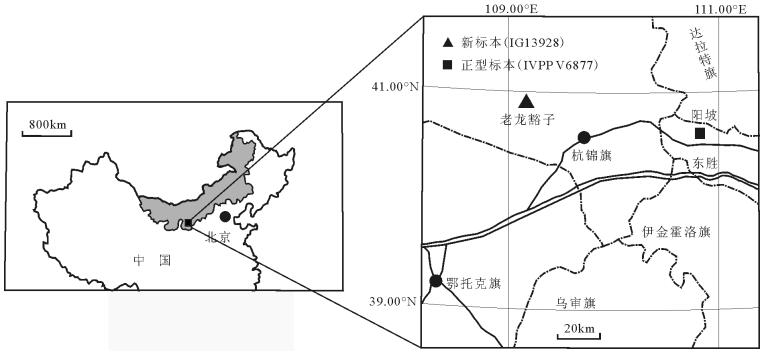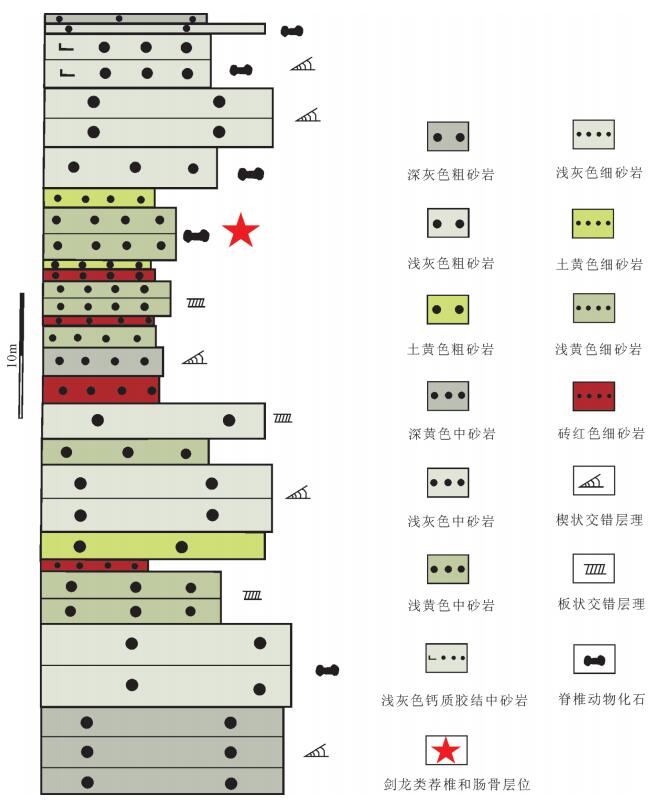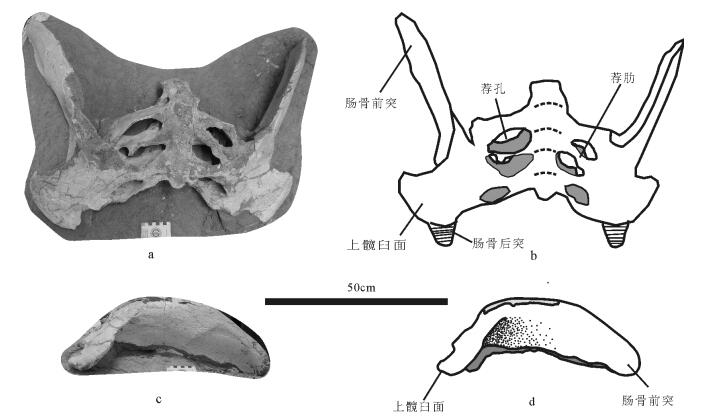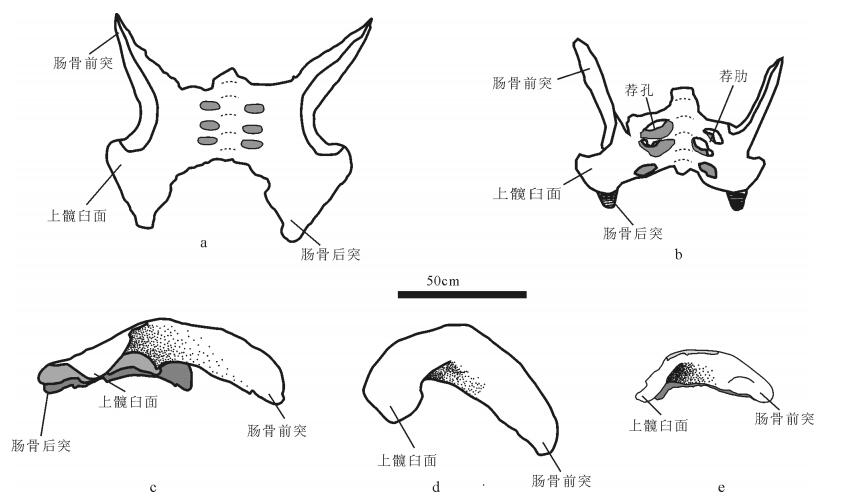New findings of stegosaurs from the Lower Cretaceous Luohandong Formation in the Ordos Basin, Inner Mongolia
-
摘要:
鄂尔多斯盆地下白垩统志丹群产出丰富的四足类动物化石:龟类、离龙类、鳄形类、鹦鹉嘴龙类、剑龙类、甲龙类、兽脚类、鸟类和早期哺乳类。采自内蒙古杭锦旗老龙豁子志丹群罗汉洞组剑龙类关联的荐椎与肠骨化石新标本,其形态特征显示该标本可被归为鄂尔多斯乌尔禾龙(Wuerhosaurus ordosensis)。该标本解剖学研究表明,鄂尔多斯乌尔禾龙腰带还具有以下特征:上髋臼面前缘向后凹而后缘内侧更加内凹。鄂尔多斯乌尔禾龙(Wuerhosaurus ordosensis)和新疆准噶尔盆地的平坦乌尔禾龙(Wuerhosaurus homheni)在腰带上存在明显区别:① 鄂尔多斯乌尔禾龙肠骨前突延伸较短,肠骨前突背缘向后逐渐向背侧拱曲、高度逐渐加大,而平坦乌尔禾龙肠骨前突后端背腹缘大致平行;② 鄂尔多斯乌尔禾龙上髋臼面较小;③ 鄂尔多斯乌尔禾龙左右肠骨前突延伸方向与中轴线之间的夹角略小于平坦乌尔禾龙。这些区别进一步表明,鄂尔多斯乌尔禾龙和平坦乌尔禾龙是不同的种。
Abstract:The Early Cretaceous Zhidan Group in the northern Ordos Basin of Inner Mongolia yielded a large number of tetrapods, which included turtles, choristoderes, crocodyliforms, psittacosaurs, stegosaurs, ankylosaurs, theropods, birds and primitive mammals. A well-preserved stegosaurian sacrum with paired ilia found from the Luohandong Formation, a middle-upper unit of Zhidan Group, is referred to as Wuerhosaurus ordosensis. The new findings give some additional characteristics to the pelvic girdle in W.ordosensis, such as both concave anterior margin and concave medio-posterior margin of the supra-acetabular flange. Based on comparison of Wuerhosaurus ordosensis with W. homheni known from Xinjiang, the authors point out the differences in ilia between the two species:① a relatively short anterior iliac process in W.ordosensis; ② the anterior iliac process with arched posterior portion of the dorsal margin in W.ordosensis, and anterior iliac process with nearly parallel dorsal and ventral margins in W. homheni; ③ the relatively small angle between anterior iliac processes and midline in W.ordosensis. These characteristics further provide the evidence that W.ordosensis and W. homheni are different species.
-
Keywords:
- Stegosauria /
- Zhidan Group /
- Luohandong Formation /
- Lower Cretaceous /
- Ordos
-
早中新世后,随着青藏高原隆升,亚洲季风增强,中国北方大部地区逐渐脱离原有的行星气候控制的干旱气候状况,向今天的暖温带季风气候系统转变[1-2],其生态系统也由原来的草原及荒漠草原为主的植被景观,转变为森林草原-落叶阔叶林为主[2]。亚洲季风区的典型暖温带植被系统不仅对全球周期性气候变化具有明显的指示意义,而且对过去数百万年时间的气候转型具有较好的响应,因此,是近年来研究过去全球变化的重点[3-4]。
晚新近纪以来,全球气候经历了几次重要的调整过程,其中最重要的就是中更新世时期全球气候格局的调整,又称中更新世转型[5-6]。其特征为从“高频低幅”的早更新世气候向中更新世以来“低频高幅”的气候波动,其气候变化周期由40ka的地轴倾斜度周期,转变为100ka 的轨道偏心率周期[7]。期间全球气候降温,陆地表面大部分地区因此变得更加寒冷干燥,冰期时,形成北美、欧洲的冰盖,非洲撒哈拉沙漠形成,亚洲内陆环境进一步干旱化,冬季季风强度增加等[7-9]。研究中更新世气候格局的重新调整,以及转型前后气候周期性对华北地区植被的影响,有利于了解不同区域植被对全球气候环境变化的响应特征,为研究重大气候转型中的生态环境效应提供重要对比参照物[10]。
华北平原主要包括淮北平原、黄河平原和海河平原三大区块,位于中国北方地区的东部,属典型的季风区。华北平原北部海河下游地区的凹陷盆地中沉积了厚度大于5000m 的新生带地层[11],其中第四系厚280~410m,最厚约450m。目前,基于这些新生带地层,华北地区的古植被研究已有较多积累,如河北黄骅HB1、衡水HS1 及天津CQJ1 孔花粉谱[12-14],天津G2 孔[15]。但是由于地层中花粉鉴定数量偏少、地层年代学不完善,以及区域地貌、沉积环境等多元因素的影响,用高质量孢粉数据来探讨更新世以来华北地区植被转型与气候变化问题的研究并不多见。本次研究利用华北地区东部天津滨海新区沉积凹陷中G3 钻孔的岩心材料,通过古地磁年代序列及较高质量的孢粉分析数据重建区域植被历史,并结合已有的植被重建资料,探讨第四纪以来华北地区的植被演变特征及气候变化过程。
1. 研究区自然地理概况
位于北纬32°~40°、东经114°~121°的华北平原是中国东部最主要的平原,平均海拔低于50m,由黄河、海河、淮河等带来的泥沙沉积而成。华北平原属暖温带季风气候,四季变化明显,冬季寒冷、少雪;春季干旱,夏季气温高、湿度大、降水集中;全年平均气温8~15℃。年平均降水量南部淮河区800~1000mm,黄河下游600~700mm,海河下游为500~600mm,年降水量分配不平衡,多年平均水面蒸发量为1625mm,降水随季节变化显著,冬、春季少,夏季集中[16]。
研究区自然植被主要由暖温带落叶阔叶林组成。在现代植被中,阔叶类的落叶栎(Quercus)植被组成受纬向的温度效应控制非常明显,在南部为麻栎(Quercus acutissima)、栓皮栎(Quercus variabilis),向北逐渐过渡为蒙古栎(Quercus mongolica)和辽东栎(Quercus liaotungensis)。针叶类以松属(Pinus)占主要地位,以赤松(Pinus densiflora)为主。另外常见温带的枫桦(Betula costata)、五加(Eleutherococcussenticosus)、核桃楸(Juglans mandshurica Max.)、椴属(Tilia)等。华北平原,尤其是海河平原,湖泊和沼泽广布,沼泽植被以芦苇(Phragmites)、香蒲(Ty⁃pha)、水葱(Scirpus)、苔草(Carex)等为主[17]。
全新世晚期以来,由于人类活动的持续加强,华北地区原生落叶阔叶林遭到大规模破坏,形成了今天普遍的灌丛及灌丛草原,其中灌木以荆条、酸枣为主,草丛以黄背草和白羊草为建群种。
2. 研究材料与研究方法
2.1 钻孔地理位置与磁性地层
天津G3 钻孔(孔口坐标:北纬117°25′59.5″、东经38°49′57.6″)位于华北平原东部天津滨海地区的海河南侧,构造上属于黄骅坳陷中的板桥凹陷。孔口高程2.65m,孔深905m(图 1)。岩心直径100mm,全孔取心率90.0%以上。因此,取心率和岩心状况满足磁性地层学及其他研究的要求。
G3 孔200m 以上磁性地层中共有6 个极性段,包括3 个正极性段(N1~N3)和3 个负极性段(R1~R3),正极性段分别为N1(0~85.0m)、N2(95.5~105.9m)和N3(177~191.8m),负极性段分别为R1(85.0~95.5m)、R2(105.9~177.0m)和R3(191.8~212.5m)。其中N1(0~85.0m)以正极性为主,并且包含明显的全新世海相层,对应布容极性时(Brunhes),故确定N1(0~85.0m)对应C1n(0~0.781Ma)。85.0~212.5m(R1~R3)以负极性为主,对应松山极性时(Matuyama),其中,N2(95.5~105.9m)对应C1r.1n(0.988~1.072Ma),为贾拉米罗(Jaramillo)正极性亚时,奥尔都微(Olduvai)正极性亚时持续事件长,且强度大,在渤海湾沿岸其他钻孔中亦有出现,因此推断N3(177~191.8m)对应C2n(1.778~1.945Ma),为Olduvai正极性亚时(图 2)。
2.2 花粉分析方法
天津滨海新区大港G3 钻孔花粉样品取样深度在0~905m 之间,取样间隔岩性为粘土、亚粘土、亚砂土和砂。每个样品重量为100g,经盐酸和氢氟酸处理、直径7μm 筛网筛选提取花粉化石。花粉鉴定统计在400 倍日本OLYMPUS 光学生物显微镜下进行,每个样品鉴定统计的花粉数是观察统计3 个玻片以上得到的。
在取得的165 个样品的大部分中发现了花粉化石,但仅在160m 以上发现连续而丰富的花粉,160m以下花粉数量稀少,绝大多数样品中不足50 粒。160m 以上共42 个样品中花粉相对丰富,其中绝大多数样品鉴定粒数高于100 粒,样品平均粒数为218粒。本文选择具有连续有效花粉数据的0~160m 地层(0~1.7Ma),用Tilia 软件对花粉图谱进行百分比图谱的绘制(图 3)。
2.3 研究结果
在42 个有效样品中,共鉴定了9167 粒花粉,分属48 个科属。其中针叶乔木花粉有铁杉属(Tsu⁃ga)、冷杉属(Abies)、云杉属(Picea)和松属(Pinus),落叶阔叶乔木花粉有桦属(Betula)、鹅耳枥属(Car⁃pinus)、桤木属(Alnus)、栗属(Castanea)、落叶栎属(Quercus)、椴属(Tilia)、胡桃属(Juglans)、榆属(Ul⁃mus)、糙叶树属(Aphananthe)、枫香属(Liquidanber)、山核桃属(Carya)、无患子科(Sapindaceae),灌木植物花粉有嚼床科(Acanthaceae)、胡秃子科(Elaeagna⁃ceae)、榛属(Corylus)、虎榛子属(Ostryopsis)、麻黄属(Ephedra)、忍冬科(Caprifoliaceae)、蔷薇科(Rosace⁃ae)。草本植物花粉有旱生的地榆属(Sangnisorba)、葎草属(Humulus)、藜科(Chenopodiaceae)、菊科(Compositea)、蒿属(Artemisia)、茜草科(Rubiace⁃ae)、唇形科(Labiatea)、豆科(Leguminosae)、茄科(Solanaceae)、蓼属(Polygonum)、十字花科(Crcife⁃rae)、石竹科(Caryophllaceae)、伞形花科(Umbella⁃les)等,水生植物有禾本科(Gramineae)、泽泻科(Alismataceae)、香蒲属(Typha)、莎草科(Cyperace⁃ae)、荇菜属(Nymphoides)。蕨类植物孢子有石松科(Lycopodiaceae)、水龙骨属(Polypodium)、凤尾蕨属(Pteridium)、卷柏属(Selaginella)、水蕨科(Parkeria⁃ceae)、单缝孢子(Monolites)和三缝孢子(Trilites)。
通过Canoco 4.5 软件对G3 孔中孢粉属种排序(图 4),发现所有属种可分为4 个类群:①以云杉、松为代表的温性针叶林;②以栎属、榛属、栗属、胡桃等为主的落叶阔叶林;③以蒿属、藜科、禾本科和桦属为主的草原及疏林草原;④以榆属、蔷薇科、胡颓子和铁杉为主的暖温性灌丛。根据属种的分布规律推断,图 4 中第一主轴(横轴)指示湿度,第二主轴(纵轴)指示温度。
如图 3 所示,根据孢粉聚类分析结果,将G3 孔中花粉百分比图谱分为4 个带。
(1)孢粉带Ⅰ:松属-云杉属-藜属-菊科-蕨类组合(1.6~1.2Ma)
乔木平均为58.6%,以松(12.7%~84.2%)和云杉(0~10.6%)为主,早期有少量铁杉,后过渡为云杉,此外还包含含量较低的栎属、榆属、椴属、桦属、胡桃属等常见暖温性阔叶乔木;草本中藜科最多,平均为8.1%,菊科含量平均4.3%,最高14.3%,蒿属含量少于菊科,平均仅2.8%。蕨类孢子在本带含量较丰富,以石松为主,另外还有水龙骨、凤尾蕨等蕨类。
本段组合指示暖温带针阔叶混交林的特点,其中松属为主要建群种,其花粉的突出代表性使松属在此时具有绝对优势。其中重要的变化在1.5Ma 前后,针叶林成分由铁杉向云杉转变的过程,显示一次降温事件,由此又可以划分出2 个阶段,即Ⅰ -1(1.6~1.5Ma)和Ⅰ -2(1.5~1.2Ma)。草本组合显示,1.5Ma 以前,菊科含量较高,而到后期,禾本科含量逐渐增加,菊科花粉基本消失,显示了区域草地环境由湿转干的过程。
(2)孢粉带Ⅱ:松属-栎属-藜-蒿组合(1.2~0.7Ma)
本段乔木花粉整体比例下降,松属比例由上段的平均51%下降至15%左右,云杉、铁杉等针叶树基本消失,但落叶栎属比例由带Ⅰ的1.2%,显著上升为13.0%,同时桦属花粉也显著增加,另有少量栗属、榆属、胡桃属等阔叶树。草本花粉组成也发生重要改变,藜科、蒿属比例大幅度增加,并伴随禾本科与香蒲属花粉的增加。蒿属平均值由原来的2.7%增加为20.7%。
本段孢粉组合指示暖温带落叶阔叶林的植被特征。草本花粉,尤其是蒿属的比例大幅度增加,显示华北地区在该阶段林地消退与草原发展,指示该时期气候干旱化。
(3)孢粉带Ⅲ:栎属-松属-藜-蒿-香蒲组合(0.7~0.3Ma)
本段乔木花粉比例最低,松属平均值由15%进一步下降,栎属略有下降,伴随较多的桦属与少量云杉属、铁杉属,并出现了零星的枫香属、山核桃属花粉。草本中藜科和蒿属依然占据主导地位,显示草原继续发展,而香蒲比例大幅度上升,显示周边地区湖泊湿地的扩展。本段孢粉组合指示疏林草原的植被景观,同时,湖泊湿地开始大规模发育。
(4)孢粉带Ⅳ:松属-栎属-藜-蒿-香蒲组合(0.3~0Ma)
本段针叶乔木花粉比例回升,松属增加至22.1%,云杉、铁杉花粉含量也有显著增加,而阔叶类乔木比例下降,栎属略微下降,枫香属、山核桃属消失,出现少量椴属、栗属、榆属、胡桃属等阔叶树。草本主要变化为藜科比例下降和香蒲比例升高。本段孢粉组合指示以暖温带落叶阔叶林为主的植被景观,湖泊湿地持续发育。
3. 讨论
3.1 演变趋势
中更新世气候转型期间,全球冰量整体增加了约15%,平均温度显著下降。对于其转型时间,大部分研究显示其大约开始于1.2Ma[6],另一些研究认为稍晚,在约1.05Ma,或是0.9Ma 前后,另外有人认为这种转型也可能是以一种渐进的方式进行的,始于1.2Ma,到约0.6Ma 才完成转型[18]。
G3 孔指示的中国华北平原地区中更新世植被转型期,对应上述的孢粉带Ⅱ,显示华北地区植被转型开始发生于1.2Ma,主要表现为林地减少,喜湿的针叶林比例下降,较为干旱的落叶阔叶林增加,同时藜科、蒿属、禾本科等草地面积显著增加。这种变化在1.2Ma 左右的某个时间点发生,大致相当于深海O 同位素36 阶段。
黄骅HB1、衡水HS1、天津CQJ2 孔、天津G2 孔的1.28~2.80Ma 为暖温带落叶阔叶林的景观,整体上较暖湿。1.28Ma以来,典型暖温带阔叶乔木花粉比例减小,华北平原草地扩张,而黄骅HB1 孔与衡水HS1 孔在中更新世前后也发生了类似事件[12-15]。
尽管由于孢粉数据分辨率的问题,所有这些钻孔的花粉百分比变化在时间上没有完好吻合,但是1.2Ma 前后,中更新世转型期推动华北平原地区植被整体向干旱类型发展是具有普遍性的。
此后,大约在0.7Ma 前后又发生一次重大转型,林地进一步退化,区域植被由原来的落叶阔叶林向疏林草原转变,对应深海O 同位素18 阶段。之后这种趋势一直延续到0.3Ma 左右才发生转变。黄骅HB1 孔中,0.8~0.7Ma 以后以蒿属和香蒲属为主,草本花粉出现,并分别达到12.5% 和10.9%,衡水HS1孔中以蒿和藜科为代表的草本花粉在0.78Ma 后也显著增长,显示华北平原0.7~0.8Ma 前后草地植被显著扩张[12-14]。此后,在约0.3Ma,即大约O 同位素8 阶段以后,华北地区植被中林地比例再度增加,可能与深海O 同位素11 阶段以后的7 阶段,5 阶段等几次典型的高温期有关。
3.2 周期性气候变化的区域植被响应
尽管由于样品分辨率的问题,周期性气候变化导致的区域植被变化未能完全被花粉谱记录,以致花粉谱更多地指示了区域植被在万年尺度的长期发展趋势。但是,不论是1.2Ma 之前的40ka 轨道倾斜度周期性,还是1.2Ma 之后的100ka 轨道偏心率周期,周期性气候变化对植被的影响,在花粉谱中确有一定表现。
例如在孢粉带Ⅰ中,以松为代表的乔木花粉比例的波动变化为10%~80%,可能对应该时期由地轴倾斜度40ka 周期变化导致的区域植被的变化。在带Ⅳ 也有类似的波动响应。由此可见,不论是1.2Ma 之前40ka 周期的“ 高频低幅”变化,还是1.2Ma 之后,100ka 周期的“低频高幅”变化,对华北地区的植被都有显著影响。
如图 3 所示,华北地区植被在1.6~1.2Ma 期间在40ka 气候周期“高频低幅”的变化中,主要表现为松属、常绿栎、铁杉属、胡桃属的交替变化,指示了区域暖温性与温性植被林地类型的交替变化。而1.2Ma 之后随着草原植被的扩张,100ka 周期的“低频高幅”变化造成的华北地区区域植被的响应更多地表现为草原与森林的交替发展。
4. 结论
华北平原东北部天津G3 孔孢粉数据及周边地区已有花粉研究表明,华北平原地区1.6Ma 以来的植被演化主要可以分为4 个阶段:①1.6~1.2Ma 密闭度较高的暖温带针阔叶混交林;②1.2~0.7Ma 开阔的暖温带落叶阔叶林;③0.7~0.3Ma,阔叶疏林草原;④0.3Ma 至今,暖温带落叶阔叶林。
中国华北平原地区中更新世植被转型期对应于孢粉带Ⅱ,显示该转型始于1.2Ma,大致对应深海O 同位素36 阶段。主要特征为林地减少、喜湿的针叶林比例下降,较为干旱的落叶阔叶林增加,同时,藜科、蒿属、禾本科等草地面积显著增加。
大约在0.7Ma 前后又发生一次重大转型,林地进一步退化,区域植被由原来的落叶阔叶林向疏林草原转变,对应深海O 同位素18 阶段。
G3 孔代表的花粉谱显示,1.6Ma 以来气候周期性的变化对华北地区区域植被有较显著的影响。
在1.2Ma 之前,受40ka 轨道倾斜度气候周期性的影响,主要表现为植被林地类型的交替发展;在1.2Ma之后,受100ka 轨道偏心率气候周期性影响,主要表现为草原与森林交替发展。
致谢: 感谢鄂托克恐龙遗迹国家自然保护区管理局张笠夫先生、中国建筑材料地质勘查中心内蒙古总队郝建强先生在野外调查过程中的帮助,以及中国科学院古脊椎动物与古人类研究所郑芳女士在平坦乌尔禾龙标本观察时给予的协助。 -
图 4 乌尔禾龙属(Wuerhosaurus)不同种的荐椎和肠骨形态比较
a—平坦乌尔禾龙(W. homheni)荐椎和肠骨背面观[25];b—鄂尔多斯乌尔禾龙(W. ordosensis)新标本(IG13928)荐椎和肠骨背面观;c—平坦乌尔禾龙(W. homheni)右肠骨侧面观[25];d—鄂尔多斯乌尔禾龙(W. ordosensis)正型标本右肠骨侧面观[15];e—鄂尔多斯乌尔禾龙(W. ordosensis)新标本(IG13928)右肠骨侧面观
Figure 4. Comparison of sacrum and ilium' s morphology of Wuerhosaurus
-
Galton P M, Upchurch P. Stegosauria[C]//Weishampel D B, Osmòlska H, Dodson P. The Dinosauria (2nd edition). Berkeley, CA:University of California Press, 2004:343-362.
Maidment S C R, Norman D B, Barrett P M. Systematics and phylogeny of Stegosauria (Dinosauria:Ornithischia)[J]. Journal of Systematic Palaeontology, 2008, 6(4):367-407. doi: 10.1017/S1477201908002459
Mateus O, Maidment S C, Christiansen N A. A new long-necked 'sauropod-mimic'stegosaur and the evolution of the plated dinosaurs[J]. Proceedings of the Royal Society B Biological Sciences, 2009, 276(1663):1815-1821. doi: 10.1098/rspb.2008.1909
Maidment S C R. Stegosauria:a historical review of the body fossil record and phylogenetic relationships[J]. Swiss Journal of Geosciences, 2010, 103(2):199-210. doi: 10.1007/s00015-010-0023-3
董枝明, 尤海鲁, 彭光照. 鸟臀类恐龙[M]. 中国古脊椎动物志, 第2卷. 两栖类, 爬行类, 鸟类. 第五册(总第九册). 北京: 科学出版社, 2015: 13-54. Dong Z M. Early Cretaceous dinosaur faunas in China:an introduction[J]. Canadian Journal of Earth Sciences, 1993, 30(10/11):2096-2100. https://www.researchgate.net/publication/237174438_Early_Cretaceous_dinosaur_faunas_in_China_an_introduction
内蒙古自治区地质矿产局.内蒙古岩石地层[M].武汉:中国地质大学出版社, 1996:269-272. Brinkman D B, Peng J H. Ordosemys leios, n. gen., n. sp., a new turtle from the Early Cretaceous of the Ordos Basin, Inner Mongolia[J]. Canadian Journal of Earth Sciences, 1993, 30(10/11):2128-2138. doi: 10.1139/e93-184
Brinkman D B, Peng J H. New material of Sinemys (Testudines, Sinemydidae) from the Early Cretaceous of China[J]. Canadian Journal of Earth Sciences, 1993, 30(10/11):2139-2152. https://www.researchgate.net/profile/Donald_Brinkman2/publication/271661754_A_new_species_of_Sinemys_Testudines_Cryptodira_Sinemydidae_from_the_Early_Cretaceous_of_Inner_Mongolia_China/links/56ec0d7d08ae24f050991339.pdf?origin=publication_detail
Tong H Y, Brinkman D B. A new species of Sinemys (Testudines:Cryptodira:Sinemydidae) from the Early Cretaceous of Inner Mongolia, China[J]. Palaeobiodiversity & Palaeoenvironments, 2013, 93:355-366. https://www.researchgate.net/publication/271661754_A_new_species_of_Sinemys_Testudines_Cryptodira_Sinemydidae_from_the_Early_Cretaceous_of_Inner_Mongolia_China
Brinkman D B, Dong Z M. New material of Ikechosaurus sunailinae (Reptilia:Choristodira) from the Early Cretaceous Luohandong Formation, Ordos Basin, Inner Mongolia, and the interrelationships of the genus[J]. Canadian Journal of Earth Sciences, 1993, 30(10/11):2153-2162. https://www.researchgate.net/publication/237174443_New_material_of_Ikechosaurus_sunailinae_Reptilia_Choristodira_from_the_Early_Cretaceous_Laohongdong_Formation_Ordos_Basin_Inner_Mongolia_and_the_interrelationships_of_the_genus
Wu X C, Brinkman D B, Lü J C. A new species of Shantungosuchus from the Lower Cretaceous of Inner Mongolia, northern China, with comments on Shantungosuchus chuhsienensis Young, 1961 and the phylogenetic position of the genus[J]. Journal of Vertebrate Paleontology, 1994, 14(2):210-229. doi: 10.1080/02724634.1994.10011553
Wu X C, Sues H D, Brinkman D B. An atoposaurid neosuchian (Archosauria:Crocodyliformes) from the Lower Cretaceous of Inner Mongolia (People's Republic of China)[J]. Canadian Journal of Earth Sciences, 1996, 33(4):599-605. doi: 10.1139/e96-044
Russell D A, Zhao X J. New psittacosaur occurrences in Inner Mongolia[J]. Canadian Journal of Earth Sciences, 1996, 33(4):637-648. doi: 10.1139/e96-047
Dong Z M. A new species of stegosaur (Dinosauria) from the Ordos Basin, Inner Mongolia, People's Republic of China[J]. Canadi-an Journal of Earth Sciences, 1993, 30(10/11):2174-2176. https://www.researchgate.net/publication/237174444_A_new_species_of_stegosaur_Dinosauria_from_the_Ordos_Basin_Inner_Mongolia_People's_Republic_of_China
姬书安, 蒋珊, 张笠夫, 等.内蒙古鄂尔多斯早白垩世甲龙类胃石与鳞片印痕化石的发现[J].地球科学前沿, 2016, 6(5):355-360. http://www.hanspub.org/journal/PaperInformation.aspx?paperID=18815 Russell D A, Dong Z M. A nearly complete skeleton of a new troodontid dinosaur from the Early Cretaceous of the Ordos Basin, Inner Mongolia, People's Republic of China[J]. Canadian Journal of Earth Sciences, 1993, 30(10/11):2163-2173. https://www.researchgate.net/publication/283412308_A_nearly_complete_skeleton_of_a_new_troodontid_dinosaur_from_the_early_Cretaceous_of_the_Ordos_Basin_Inner_Mongolia_People%27s_Republic_of_China
Currie P J, Dong Z M. New information on Cretaceous troodontids (Dinosauria, Theropoda) from the People's Republic of China[J]. Canadian Journal of Earth Sciences, 2001, 38(12):1753-1766. doi: 10.1139/e01-065
侯连海.内蒙古晚中生代鸟类及鸟类飞行进化[J].古脊椎动物学报, 1994, 32(4):258-266. http://www.cnki.com.cn/Article/CJFDTOTAL-GJZD199404006.htm Li J J, Li Z H, Zhang Y G, et al. A new species of Cathayornis from the Lower Cretaceous of Inner Mongolia, China and its stratigraphic significance[J]. Acta Geologica Sinica (English Edition), 2008, 82(6):1115-1123. doi: 10.1111/j.1755-6724.2008.tb00711.x/full
Godefroit P, Guo D Y. A new amphilestid mammal from the Early Cretaceous of Inner Mongolia (P. R. China)[J]. Bulletin de l'Insti-tut Royal des Sciences Naturelles de Belqique, Sciences de la Terre, 1999, 69(Supplément B):7-16. https://www.researchgate.net/publication/285955993_A_new_amphilestid_mammal_from_the_Early_Cretaceous_of_Inner_Mongolia_PR_China
Galton P M. Species of plated dinosaur Stegosaurus (Morrison Formation, Late Jurassic) of western USA:new type species designation needed[J]. Swiss Journal of Geosciences, 2010, 103(2):187-198. doi: 10.1007/s00015-010-0022-4
Marsh O C. Principal characters of American Jurassic dinosaurs; Part Ⅰ X, The skull and dermal armor of Stegosaurus[J]. American Journal of Science, 1887, 203:413-417.
Carpenter K. Species concept in North American stegosaurs[J]. Swiss Journal of Geosciences, 2010, 103(2):155-162. doi: 10.1007/s00015-010-0020-6
董枝明.乌尔禾恐龙化石[J].中国科学院古脊椎动物与古人类研究所甲种专刊, 1973, (11):45-52. http://www.cnki.com.cn/Article/CJFDTOTAL-HMPS201512039.htm




 下载:
下载:







